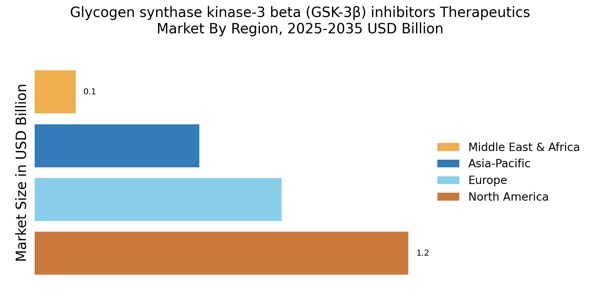Growing Investment in Biotechnology
The surge in investment within the biotechnology sector is a crucial driver for the Glycogen synthase kinase-3 beta (GSK-3β) inhibitors Therapeutics Market. Venture capital funding and public-private partnerships are increasingly directed towards biopharmaceutical companies focusing on GSK-3β inhibitors. In 2025, investments in biotechnology are anticipated to exceed USD 200 billion, reflecting a robust interest in novel therapeutic approaches. This influx of capital is likely to accelerate research and development efforts, leading to the discovery of new GSK-3β inhibitors and enhancing their market presence. Furthermore, increased funding can facilitate collaborations between academic institutions and industry players, fostering innovation in GSK-3β inhibitor therapeutics.
Rising Prevalence of Chronic Diseases
The increasing prevalence of chronic diseases such as diabetes, Alzheimer's, and cancer is a primary driver for the Glycogen synthase kinase-3 beta (GSK-3β) inhibitors Therapeutics Market. As these conditions become more widespread, the demand for effective therapeutic options rises. GSK-3β inhibitors have shown promise in preclinical and clinical studies for their potential to modulate various disease pathways. For instance, the market for diabetes therapeutics alone is projected to reach USD 100 billion by 2025, indicating a substantial opportunity for GSK-3β inhibitors. This trend suggests that pharmaceutical companies are likely to invest more in developing GSK-3β inhibitors, thereby expanding their therapeutic applications and enhancing market growth.
Regulatory Support for Innovative Therapies
Regulatory agencies are increasingly supportive of innovative therapies, which is positively impacting the Glycogen synthase kinase-3 beta (GSK-3β) inhibitors Therapeutics Market. Initiatives aimed at expediting the approval process for breakthrough therapies are encouraging pharmaceutical companies to invest in GSK-3β inhibitors. For instance, the FDA's Fast Track designation allows for accelerated development and review of drugs that address unmet medical needs. This regulatory environment is likely to enhance the attractiveness of GSK-3β inhibitors, as companies can bring their products to market more swiftly. Consequently, this support may lead to a more dynamic market landscape, with a greater variety of GSK-3β inhibitors available to patients.
Advancements in Drug Development Technologies
Technological advancements in drug development are significantly influencing the Glycogen synthase kinase-3 beta (GSK-3β) inhibitors Therapeutics Market. Innovations such as high-throughput screening, artificial intelligence, and bioinformatics are streamlining the drug discovery process. These technologies enable researchers to identify potential GSK-3β inhibitors more efficiently, reducing the time and cost associated with bringing new drugs to market. The integration of these technologies has the potential to increase the number of GSK-3β inhibitors entering clinical trials, thereby expanding the therapeutic landscape. As a result, the market is expected to witness a surge in new entrants and innovative treatment options, fostering competition and growth.
Increased Awareness of Mental Health Disorders
The rising awareness of mental health disorders is emerging as a significant driver for the Glycogen synthase kinase-3 beta (GSK-3β) inhibitors Therapeutics Market. Conditions such as depression and bipolar disorder are gaining recognition, leading to a greater demand for effective treatments. GSK-3β inhibitors have been investigated for their potential neuroprotective effects and ability to modulate mood disorders. As mental health becomes a priority in healthcare discussions, the market for GSK-3β inhibitors is likely to expand. The mental health therapeutics market is projected to reach USD 100 billion by 2025, indicating a substantial opportunity for GSK-3β inhibitors to address these critical health issues.


















Leave a Comment